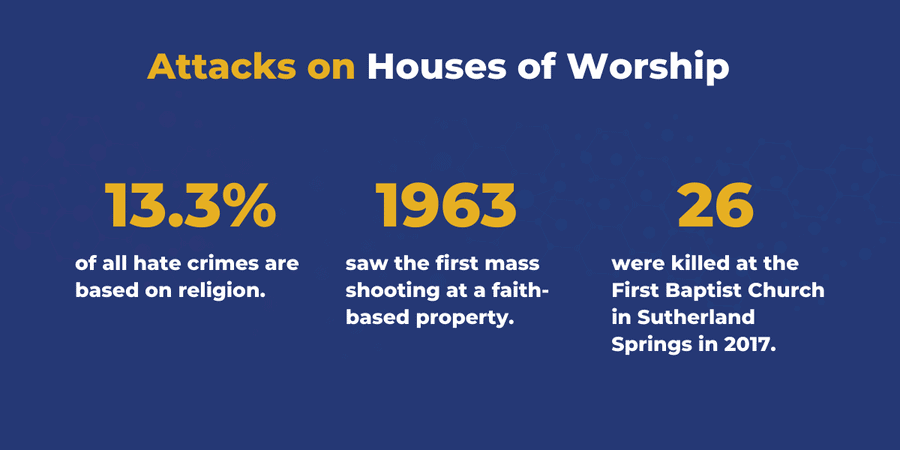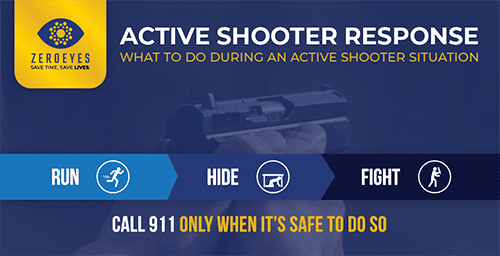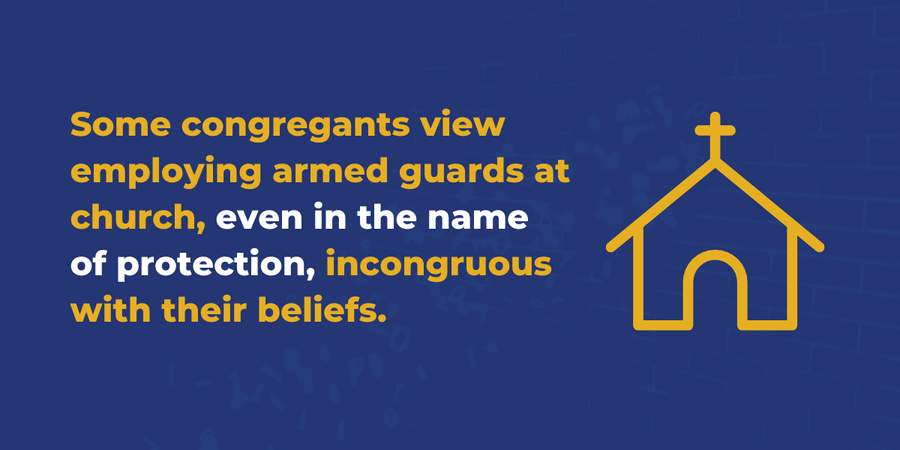Church shootings are becoming an increasing threat to the religious communities of America. The United States Justice Department has determined that 13.3% of all hate crimes are based on religion—a striking statistic considering how unprotected many churches are to the threats of an active shooter.
Because mass shootings in churches are relatively rare, many church leaders don’t feel the sense of urgency to make immediate security improvements. The fact is, however, that these horrific attacks are on the rise, and religious organizations have a responsibility to protect their followers while gathered in church.
Shootings in Churches are on the Rise
Tragically, mass shootings in churches are on the rise. What was once considered a sanctuary of peace and solemnity has now become a target for hatred. According to the Faith Based Security Network, there had never been a mass shooting on a faith-based property before 1963, yet there have already been four this year in Christian churches alone.
There is a documented association between social climate and threats to houses of worship, suggesting that periods of intense strife—such as the COVID-19 pandemic—often accompany attacks on distinct ethnic and religious groups.
How are Mass Church Shootings Defined?
The Federal Bureau of Investigation (FBI) defines a mass shooting event as one with 4+ casualties, excluding the shooter. While no loss of life should be taken lightly, it is important to understand the scale at which these attacks take place in churches. With limited security measures on-site, the casualties at church shootings tend to skew higher. The mass shooting at the First Baptist Church in Sutherland Springs, for example, claimed 26 lives and is currently the 5th deadliest mass shooting incident in United States history.

Mass Shootings at Church and Their Impacts on the Community
This undeniable rise in shootings at churches and other houses of worship has created what many fear will be a long-lasting impact on religious communities around the country. While the leaders of these faith communities want to do everything within their power to protect their parishioners, they struggle to find solutions that don’t impose on the sanctity of their worship.
But while church leadership debates on the best way to handle this frightening trend of church, the following is happening within their faith communities:
- Members who don’t feel safe in church are no longer attending in-person services, resulting in poor attendance and monetary strife.
- Members who worship in person may be doing so despite their fear, which can impact the positive environment and create toxicity in the community.
- Non-members may pass judgment on the perceived safety of the church, damaging the reputation of the religious community and its parishioners.
While it can be difficult to plan for an unspeakable tragedy in a place of worship, the undeniable fact of the rise of church shootings demands that actions be taken.
Preparing for an Active Shooter in Church
Discussing an active shooter among church leadership and the larger faith community is an uncomfortable task. While the odds of an attack are certainly slim, one must do everything within their power to ensure the best outcome should the unthinkable happen.
Church Security Plans & Procedures
The first step towards preparing for a church shooter is creating a church safety plan. In a recent survey by Lifeway Research, 62% of pastors say they have an intentional plan for active shooters. Creating a safety plan is an ideal place to start general preparations because it is a cost-free way to honestly discuss and assess the safety concerns of a religious community.
- Inspect The Grounds
Do a thorough review of the interior and exterior of the entire premises. Determine points of access where assailants can easily enter or hide. Plan for volunteers to regularly walk the perimeter during services to check for suspicious activity, especially at these high-risk points. - Contact Local Law Enforcement
Establish a relationship with your local police and fire departments. Have them visit the location to get their suggestions and advice on how to improve safety on the premises. Create an open line of communication for sharing concerns about parishioners’ safety. - Create Emergency Response Procedures
Develop exit strategies in case of shootings, and offer training in first aid and CPR for members of the community. Having well-prepared worshipers would be helpful for any emergency, like harsh weather, a fire, or medical emergencies. - Tighten Protocols
Take stock of what doors are open, who has access to keys and any other security issues that might not have been recently assessed. Though locking doors may be contrary to the spirit of openness and acceptance, these precautions can prevent a bad actor from having easy access.
What to do During a Church Shooting Event
The proactive items above are an excellent first step to mitigate the impact of violence in church shootings. The next crucial action is to make sure all members of the church community know what to do in the event of violence. It can be painful to imagine the unthinkable happening in a place so sacred and familiar, but practicing these steps can help empower you to act appropriately during a shooting and help others survive.
Developed and endorsed by the FBI, the protocol of Run, Hide, Fight has saved countless lives during recent church shootings.
- Run.
Make sure members of the congregation know where the exits to the building are and how to best make their way quickly out of the building. Stress that they should leave behind all their belongings and help others escape if possible. Crucially, it is important that nobody attempts to move wounded individuals. While it may go against every helping instinct, trying to help someone who is injured decreases the chances of survival for both parties - Hide.
If you are unable to escape an active church shooting, your next best option is to hide. Do everything possible to stay out of the shooter’s view, including locking and blocking every door that might be in their way. Silence all cell phones and encourage everybody to stay quiet, so as to not draw the shooter’s attention to your hiding place. While hiding, keep aware of your surroundings and always be ready to escape the building if a safe opportunity presents itself. - Fight.
As an absolute last resort, individuals present during a church shooting should be prepared to fight. Acting aggressively and attempting to incapacitate the shooter by any means necessary may save time and increase chances for survival. Consider throwing objects and yelling for help—try anything to distract or discourage the shooter.
Be sure to call 911 only when it is safe to do so. Provide clear information to the operators and follow all instructions of emergency personnel. When law enforcement arrives, drop all objects you may be holding and keep your hands visible—showing you are unarmed helps police gain critical situational awareness in a chaotic church shooting event.

Free Resource: Run, Hide, Fight Infographic
Examples of Protection Against Shootings in Church
There are many schools of thought on how to best protect against an active church shooter. While member safety is of top concern to any religious leader, there are many factors that go into determining what they are comfortable with in their houses of worship. Below are three common approaches to protection against church shooters.
Churches as Gun-Free Zones
One of the first steps churches take is creating a gun-free zone on their campus. This typically consists of nothing more than a sign declaring that the possession of a gun is illegal on the premises. While this may be well-meaning, it may cause more problems than solutions as mass shooters may choose gun-free zones as easy targets, knowing nobody there will be armed. In fact, a study by the Crime Prevention Research Center found that 97.8% of public mass shootings happen in gun-free zones.
On-Site Church Security
Another popular method of preventing church shootings is having some form of security onsite. A recent Lifeway survey of Protestant pastors reported that 23% had armed private security personnel on site, and 6% said they have uniformed police officers stationed in church during services.
Having a visible security officer present during services may certainly deter a potential church shooter, but it creates its own controversies. A secondary survey from the same research firm reported an array of statistics broken down by religion, sex, and race show radically different levels of comfort and perceived safety by having armed, uniformed policemen in church.
Armed Church Parishioners
For churches uncomfortable with having a uniformed police officer present during services, many have turned to having screened parishioners attend services with concealed weapons. These trained volunteers provide an unseen level of protection that some worry comes as a “spiritual cost.” No matter the intention, some congregants view bringing a firearm to church—even in the name of protection—as a “warfare” approach incongruous with their beliefs.

Stopping Church Shootings With Gun-Detection Technology
The failures of the three most common approaches to preventing mass church shootings are efficacy (gun-free zones), optics (on-site security) and ethics (armed parishioners). An elegant solution that can solve these three problems for houses of worship—and save lives—is visual gun detection technology.
ZeroEyes is a discreet visual gun-detection system that uses advanced artificial intelligence to stop mass shootings before they happen. Integrated into existing security cameras, it communicates instantaneously with local 911 and first responders the moment that a weapon is visually detected on your premises.
By sending real-time data to law enforcement and your staff, you’ll know exactly where the would-be assailant is, what they look like, and what they are doing. This provides you with the information you need to get your worshipers to safety and gives police the information they need to quickly neutralize the threat to your congregation. Exterior cameras would be very helpful for this purpose, possibly stopping an attacker before he enters the building.
Reclaiming Safety in the Age of Church Shootings
In 2017, a gunman parked outside of a church and walked through the main doors of the sanctuary while a service was in progress. The congregation, whose back faced the main entrance, was caught unaware when he opened fire. One person died and eight were injured.
When the congregation began the process of healing after this tragedy, it was decided that major renovations were necessary in the church building to bring new life to this community. One of the changes: moving the main entrance to a location where the seated congregation could see who was entering their church during services.
One cannot put a price on the feeling of safety. For these parishioners healing from the tragedy that took place in their church, a visible entryway surely goes a long way toward peace of mind. But for communities not yet impacted by the rise of gun-related violence, peace of mind doesn’t have to come at the cost of major structural renovations. There are tangible steps all can take towards today restoring physical and emotional security in churches.
Learn more about how ZeroEyes’ Visual A.I. Gun Detection can prevent shootings and hate crimes in churches, provide peace of mind, and save lives.

